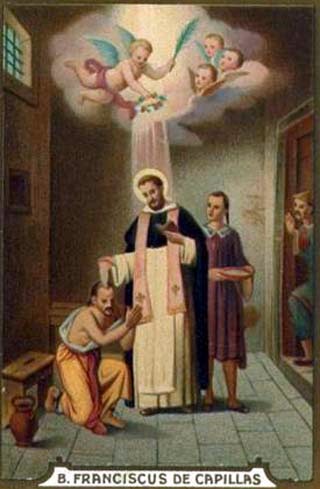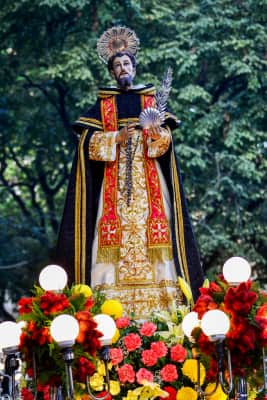dominican saints
Bl. Francis of Capillas, M.O.P.
Feast Day January 15th

Born: 1608 in Old Castile, Spain
Died: Martyred in January 15, 1640 in China
Beatified: May 2,1909 by Pope Pius X
The 17th century was a period of great missionary activity. Many martyrs shed their blood on distant shores. Dominicans and Jesuits contributed a great share to the blood of martyrs. Among this glorious company, the Dominican Francis de Capillas has become the type and exemplar of them.
Nothing is known of his childhood. He entered the Dominicans at Valladolid at age 17. The Spain of his youth was still ringing with the missionary zeal of Saints Louis Bertrand, Philip de las Casas, and Francis Xavier; the report of the martyrdom of Alphonsus Navarette (June 1), in Japan, was news at the time. Perhaps the bravery of these men helped to fire the young Francis with apostolic longing, for he volunteered for the Philippine mission while he was a deacon. At age 23 (1631) he left Spain and was ordained in Manila. Here, at the gateway to the Orient, the Dominicans had founded a university in 1611, and the city teemed with missionaries traveling throughout the Orient.
The young priest labored for 10 years in the province of Cagayan, the Philippines, where heat, insects, disease, and paganism leagued against the foreigner to make life very hard. But it was not hard enough for Francis. He begged for a mission field that was really difficult; perhaps, like many of the eager young apostles of that time, he was hoping for an assignment in Japan, where the great persecution was raging. He was sent to Fukien, China, where he worked uneventfully for some years. Then a Tartar invasion put his life in jeopardy. He was captured by a band of Tartars and imprisoned as a spy.
Francis, like his Master, was subjected to a mock trial. Civil, military, and religious officials questioned him, and they accused him of everything from political intrigue to witchcraft. He was charged with disregarding ancestor worship, and, finally, since they could “find no cause in him,” he was turned over to the torturers.
He endured the cruel treatment of these men with great courage. Seeing his calmness, the magistrates became curious about his doctrines. They offered him wealth, power, and freedom, if he would renounce his faith, but he amazed and annoyed them by choosing to suffer instead. They varied the tortures with imprisonment, and he profitably used the time to convert his jailor and fellow prisoners. Even the mandarin visited him in prison, asking Francis if he would renounce his faith or would he prefer to suffer more. Being told that he was glad to suffer for Christ, the mandarin furiously ordered that he be scourged again “so he would have even more to be glad about.”
Francis was finally condemned, as it says in the breviary, as “the leader of the traitors,” these being (presumably) the rebel army that was besieging the city. The official condemnation is stated in those words: “After long suffering, he was finally beheaded and so entered into the presence of the Master, who likewise suffered and died under a civil sentence” (Benedictines, Dorcy).
biography of bl. francis of capillas
The life of Francis de Capillas was so penitential and angelic that one of the Cardinals present at the Process of Beatification declared that even if Francis had not died for the faith he could still be beatified. As the first to shed his blood for Christ in China, he is honored as the protomartyr of China.
Francis was born in Baquerín de Campos, Palencia (Spain) on 14 August 1607. He entered the Dominican Priory of St. Paul in Valladolid. In February 1632, after he arrived in Manila, he was ordained to the priesthood. His
first assignment was in the province of Cagayan where he ministered for several years.
In 1641, Capillas attended the Provincial Chapter held in Manila and asked the new provincial, Father Francis de Paula, to permit him to evangelize in the Celestial Empire. He was allowed to go with his friend, Father Francis Díaz. They arrived in Formosa and stayed at the House of All Saints in Kilung. In March 1642, they arrived at Fukien, China. Due to the persecution that raged there, the only priest left to welcome them was Father John
García.
Father Capillas began his pastoral ministry at once. The years 1644 to 1646 are called the golden age of the mission. Capillas and Díaz established the Lay Dominicans in China.
Capillas visited all the towns and villages in Fogan and Funing, converting large numbers of Chinese. His highly virtuous life and conduct won for him the love and respect of all whom he met. Francis Díaz died on 4 November 1646, assisted by his friend, Francis Capillas. On that same day, the Tartars entered Fogan, destroying, looting and killing. In addition, they had an Imperial order to kill the missionaries.
The apostolic works accomplished by Father Capillas were innumerable. One witness said: “When he was on the road, he had such a great desire to help souls that climbing the steep roads of mountains seemed easier than walking level roads.”
Hearing of the advancing army, Father John García fled during the night to Tingtau where Father Capillas was staying. Without any fear, Father Capillas went out to a small village on 13 November 1647, to administer the sacraments to a sick person. On that day, he was captured, one year after Father Díaz’s death. With a rope tied around his neck, Capillas was taken to the Mandarin’s tribunal. He was placed into the worse prison and subjected to the torture of crushing the ankles. The torturers dragged him all over the floor before taking the boards off his feet. They then flogged him and returned him to the cells for those condemned to death.
Father Capillas remained incarcerated for two months. He patiently endured the horrible torments that were inflicted on him. On 15 January 1648, the judge came and ordered that he be flogged again and placed into the sentry box of the city wall. When they ordered him to step down from the box, the executioners gave him a heavy blow with a sword, separating his head from his body. They threw his body outside the city wall, where it was found two months later.
Pope Benedict XIV proclaimed him the protomartyr of China on 16 September 1748. Pope Pius X beatified him on May 2, 1909. His individual feast is on January 15.
Witnesses of the Faith in the Orient, Dominican Martyrs of Japan, China, and Vietnam.
Prayers/Commemorations
First Vespers:
Ant. This is a martyr indeed, who for the Name of Christ shed his blood; who neither feared the threats of judges, nor sought the glory of earthly dignity, but has joyously come to the the heavenly kingdom.
V. Pray for us, Blessed Francis.
R. That we may be worthy of the promises of Christ.
Lauds:
Ant. Let him that would come after Me de deny himself, take up his cross and follow Me.
V. A crown of gold is on his head.
R. Signed with the sign of sanctity.
Second Vespers:
Ant. This is he for the law of his God delivered himself to death. He did not hesitate to die; he was slain by the wicked and lives forever with Christ: he followed the Lamb and has received the palm.
V. Pray for us, Blessed Francis
R. That we may be made worthy of the promises of Christ.
Prayer:
Let us Pray: O God, who didst strengthen with wonderful constancy the faith of Thy Blessed martyr, Francis, grant propitiously to Thy church, that aided by his prayer it may deserve to celebrate in all places new triumphs of faith. Through Christ our Lord. Amen.
